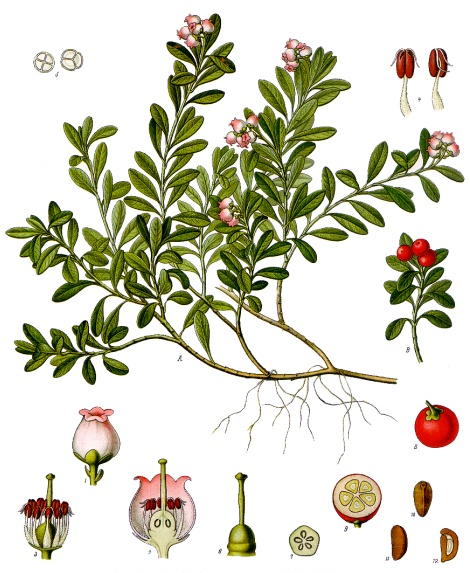
Arctostaphylos uva-ursi (Spreng.)
Synonyms: uva ursi, mountain cranberry, sandberry, arberry, bear's grape, kinnikinnick, mealberry, mountain box, red bearberry, sagackhomi, rockberry, upland cranberry, hogberry
Order: Ericaceae
 Description: This is a small evergreen creeping
shrub indigenous to Europe, Asia and the northern United States and Canada,
where it grows on rocky hills. A single, long, fibrous main root sends out
several prostrate or buried stems from which grow erect, branching stems up to
15cm high. The bark is dark brown or reddish. The leaves are shiny oblong, with
entire margins up to 2.5cm long; the small pink to white bell-shaped flowers
occur in drooping terminal racemes in groups of four to six. They give way to
globular bright red berries containing several one-seeded nutlets.
Description: This is a small evergreen creeping
shrub indigenous to Europe, Asia and the northern United States and Canada,
where it grows on rocky hills. A single, long, fibrous main root sends out
several prostrate or buried stems from which grow erect, branching stems up to
15cm high. The bark is dark brown or reddish. The leaves are shiny oblong, with
entire margins up to 2.5cm long; the small pink to white bell-shaped flowers
occur in drooping terminal racemes in groups of four to six. They give way to
globular bright red berries containing several one-seeded nutlets.
Parts used: Leaves
Collection: The evergreen leaves may be collected throughout the year, but preferably in September or October.
Constituents: Hydroquinone glycosides (including 8% arbutin, methyl-arbutin and ericolin), Iridoids, 6% tannins, flavonoids, allantoin, resin (ursone), volatile oil, ursolic, malic and gallic acids.
Actions: Diuretic, astringent effect on lower digestive tract, urinary antiseptic, demulcent
Indications: cystitis, urethritis, dysuria, pyelitis, lithuria
Therapeutics and Pharmacology: Arctostaphylos has a marked antiseptic and astringent effect on the membranes of the urinary system, soothing, toning and strengthening them. It is specifically used where there is gravel or ulceration in the kidney or bladder. It may be used in the treatment of infections such as pyelitis urethritis and cystitis and is specifically indicated in acute catarrhal cystitis with dysuria and highly acid urine, where it helps to reduce accumulations of uric acid. With its high astringency it is used to treat some forms of enuresis and in diarrhoea. It is also used to treat dysuria. As a douche it may be helpful in vaginal ulceration and infection. Arbutin is the principal constituent leading to antibacterial activity, inhibiting the growth of Citobacter, Enterobacter, Escherichia, Klebsiella, Proteus, Pseudomonas and Staphylococcus (Kedzia) - and also by the breakdown of ericolin to a volatile component ericinol. There is thus a delayed-action effect which manifests only at the site of action. Arbutin is converted to glucose and the antiseptic hydroquinone in the kidney tubules, but only if the urine is alkaline. Although Arctostaphylos has long been described as a diuretic, in one pharmacological study it was actually shown to inhibit diuresis.
 The high tannin content of Arctostaphylos has an astringent action on the lower digestive tract,
and it is used in the management of diarrhoea and to reduce intestinal irritation.
The high tannin content of Arctostaphylos has an astringent action on the lower digestive tract,
and it is used in the management of diarrhoea and to reduce intestinal irritation.
Combinations: It may be combined with Althaea root, Agropyron, Zea and Barosma in cystitis.
Caution: Arctostaphylos is contraindicated during pregnancy due to its oxytocic properties. Large doses may lead to nausea and vomiting due to the high tannin content. Treatment should be of short duration (7 days) and an alkaline diet should be taken during treatment. Long-term use may produce toxic effects as large doses of hydroquinone are poisonous. The herb should perhaps be avoided if the kidney itself is affected. It may change the colour of the urine but this is harmless..
Preparation and Dosage: (thrice daily)
Regulatory status GSL
Dried leaves: 1.5-2.5g or by infusion
Concentrated Infusion B.P.C. (1934), 2-4ml
Liquid Extract: 1:1 in 25% alcohol, 1.5-2.5ml
Tincture: 1:5 in 25% alcohol, 2-4ml
Additional Comments: Uva-ursi was used in the 13th century by the Welsh Physicians of Myddfai. It was described by Clusius in 1601 and recommended for medicinal use in 1763 by Gerhard of Berlin. It appeared in the London Pharmacopoeia in 1788, though was probably in use long before. The tannin in the leaves was used in the past to tan leather in Sweden and Russia and an ash-coloured dye is said to be obtained from the plant in Scandinavia. Cattle avoid it. The leaves from A.glauca (manzanita) from California, A.polifolia from Mexico, and A.tomentosa (madrona) are also used medicinally.
Bibliography
BHMA 1983 British Herbal Pharmacopoeia, BHMA, Bournemouth.
Bradley, P.R. (ed.) 1992 British Herbal Compendium, Volume 1, BHMA, Bournemouth.
Grieve, M. 1931 A Modern Herbal, (ed. C.F. Leyel 1985), London.
Hoffmann, D. 1990 The New Holistic Herbal, Second Edition, Element, Shaftesbury.
Lust, J. 1990 The Herb Book, Bantam, London.
Mabey, R. (ed.) 1991 The Complete New Herbal, Penguin, London.
Mills, S.Y. 1993 The Essential Book of Herbal Medicine, Penguin, London (First published in 1991 as Out of the Earth, Arkana)
Mills, S.Y. 1993 The A-Z of Modern Herbalism, Diamond Books, London.
Ody, P. 1993 The Herb Society's Complete Medicinal Herbal, Dorling Kindersley, London.
Polunin, M. and Robbins, C. 1992 The Natural Pharmacy, Dorling Kindersley, London.
Weiss, R.F. 1991 Herbal Medicine, Beaconsfield Arcanum, Beaconsfield.
Wren, R.C. 1988 Potter's New Cyclopaedia of Botanical Drugs and Preparations, C.W.Daniel, Saffron Walden.










